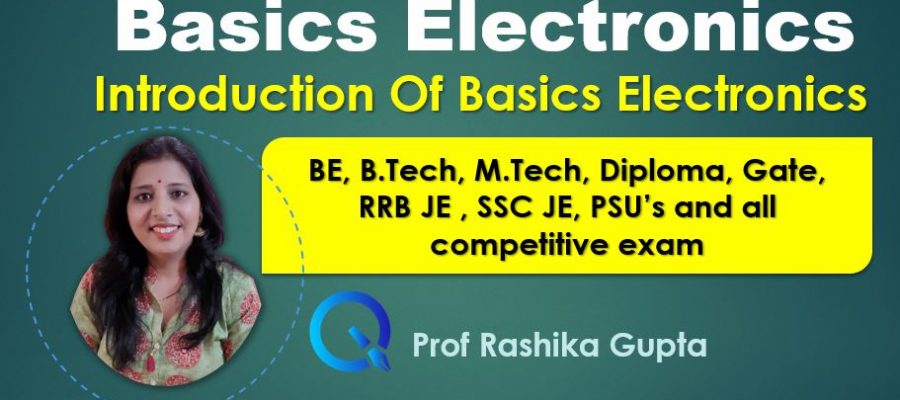If you want to know about basics of electronics and its components & devices. In this article I have explained what is electronics, history, active component, passive component, applications of electronics, current, voltage. This article give you basic understanding of electronics and help in your semester exam or competitive exam.
What Is Electronics ?
The word electronics derive from two words electron and mechanics. Which mean here we study the behavior of an electron under the influence of applied electric field and/or magnetic field.
Definition of electronics
“Electronics is a branch of physics and electrical engineering that deal with electrical device and circuits that operate by controlling the flow of electron or other charge particles. It also deal with, how electron behave in gases, vacuum or semiconductor.“
History Of Electronics
Diode vacuum tube was the first electronic component invented by J.A. Fleming.
Lee De Forest developed the triode, a three element vacuum tube capable of voltage amplification.
In 1948 Bell laboratories developed the first transistor based on the research of Shockley, Bardeen and Brattain.
In 1960’s the process of microminiaturization i.e., reduction in the size of electronic equipment to extremely small dimension led to the invention of integrated circuit (IC’s), Jack Kilby of Texas Instruments developed the first integrated circuit (IC).
The early IC technology is referred to as small scale integrated circuit (SSI). Further developments in IC technology resulted progressively in medium scale integration (MSI), large scale integration (LSI), very large scale integration (VLSI), Ultra-large scale integration (ULSI) and giant-scale integration (GSI).
This microminiaturization of electronic component made revolutionary change in the field of electronics and has resulted in the development of products like hand calculators, computers, microprocessor, microcontrollers and communication satellites.
Electronic Components & Devices
Passive Component:
- passive component is an electronic component which store or absorb energy in the form of voltage or current.
- The component which can’t control the flow of current.
- Passive component can’t provide any power gain to the circuit.
- Example: Registers, Capacitors, Inductors, Transformers.
Active Component:
- Active component is an electronic component which generate energy in the form of voltage or current.
- They supply energy to the circuit and they can control the flow of current.
- Active component can provide any power gain to the circuit.
- Example: Transistors, Triode, Vacuum tube, Voltage source.
What Is Circuits ?
- Circuit can be electrical, electronic, analog, digital, synchronous, a synchronous etc.
- Electrical Circuits: A complete electrical network is an interconnection of electrical components which provide a closed path or loop for current.
- Electronic Circuit: It is the combination of electronics component capable of performing computation, amplification and data transfer.
- Analog Circuit & Digital Circuit: Analog Circuit uses continuous and digital circuit uses discrete signal level, respectively.
There are two type of circuits
- Series Circuit
- Parallel Circuit
Series Circuit :
- Series circuit components are wired one after another component.
- In series circuit electricity will pass through first component, then the next component , then next component and so on.
- In series circuit, the current through each of the component is same, and the voltage across the circuit is the sum of the voltage across each component.
Parallel Circuit :
- In parallel circuit Components are wired side by side.
- In parallel circuit electricity will pass through all of them at the same time, From one common point to another common point .
- In parallel circuit, the voltage across each of the components is same, and the total current is the sum of the current through each component.
Closed circuit & Open Circuit
Closed Circuit : A complete electrical circuit through which current can flow when a voltage is applied.
A closed circuit will allow the flow of electricity between power and ground.
Open Circuit: A Incomplete electrical circuit through which no current can flow. Open circuit will break the flow of electricity between power and ground.
Current & Voltage
Current (I)
- Current is the movement or flow of electric charge.
- According to the Ohm’s law current is given by I = V/R
- Measuring unit of current is ‘Amperes’
Voltage (V)
- Voltage is the potential difference between two points.
- According to the Ohm’s law voltage is given by V = I*R
- Measuring unit of voltage is ‘Volts’
Application Of Electronics
- Communication: Mobile phones, Fax, Computers, telephony and telegraphy, optical communication, wireless communication etc.
- Entertainment: Video games, Music player, Television, headphones, DVD players, VCRs, microphones, loudspeakers etc.
- Medical devices: X-Ray, ECG machines, MRI , Ultrasound, Electronic weight scale, Heart rate monitor etc.
- Defence: Radar, Missile etc.
- Industries: Industrial automation and motion control, Machine learning, motor drive control, Mechatronics and robotics, Power converting technologies, Photo voltaic systems, Renewable energy applications, Power electronics, and Biomechanics.

